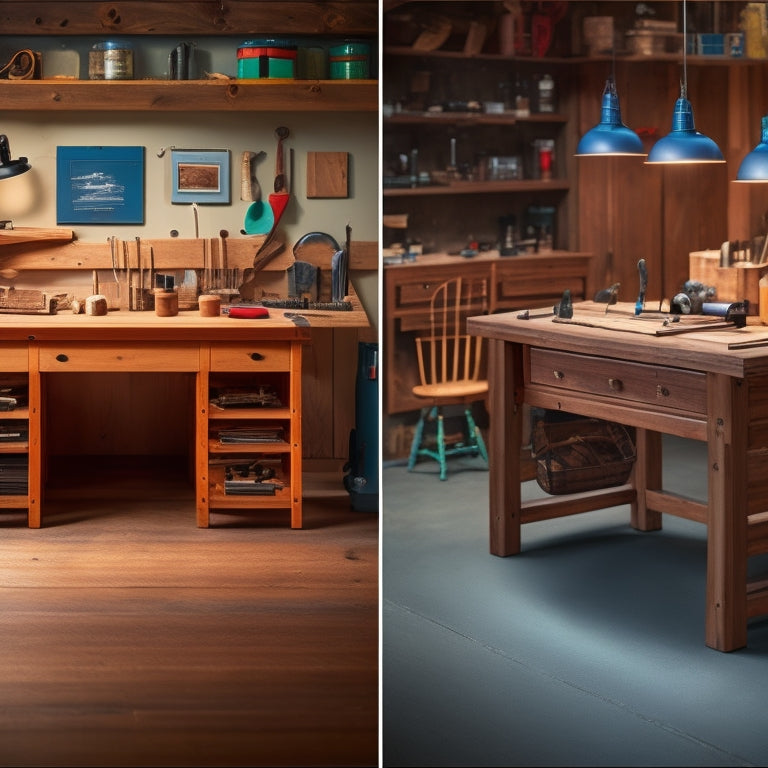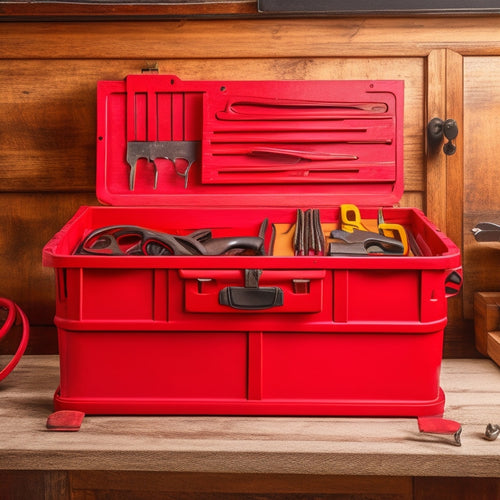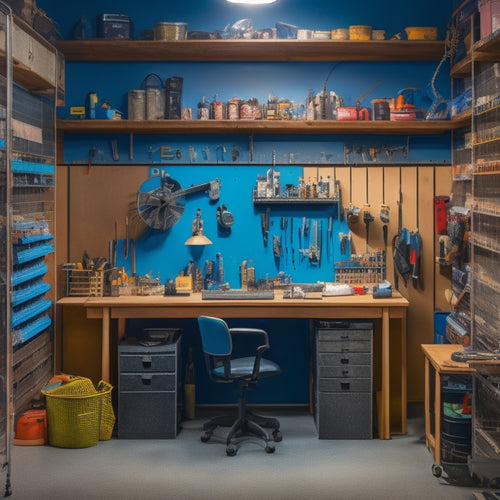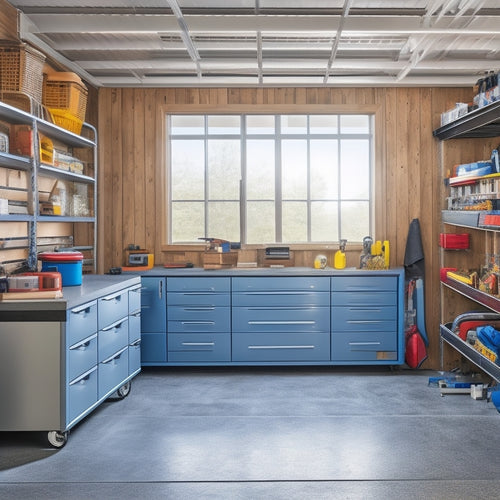
Softwood Vs Hardwood for Workbench Wood
Share
When deciding on softwood or hardwood for your workbench, you'll want to evaluate the trade-offs between durability, weight, and cost. Softwoods like pine or fir are lighter and more budget-friendly, but they're prone to moisture absorption and warping. Hardwoods like oak or maple, on the other hand, offer superior moisture resistance and strength, but they're heavier and pricier. You'll also need to reflect on the wood's grain pattern, texture, and aesthetic appeal, as well as its compatibility with tools and hardware. As you weigh these factors, you'll uncover that the right wood choice can make all the difference in creating a workbench that meets your needs and stands the test of time, and there's more to investigate on this critical decision.
Key Takeaways
- Softwood workbenches are lightweight and versatile, but prone to moisture absorption, warping, and decay, making them less durable than hardwood.
- Hardwood workbenches offer superior moisture resistance, density, and strength, but are heavier and more expensive than softwood options.
- The choice between softwood and hardwood significantly affects the workbench's suitability for various tasks, with hardwood being more suitable for heavy-duty use.
- Engineered and hybrid woods offer balanced weight distribution, improved stability, and mid-range pricing options, making them a viable alternative to softwood and hardwood.
- When selecting wood for a workbench, consider factors such as durability, moisture resistance, weight, stability, cost, aesthetic appeal, and tool compatibility to ensure optimal performance and safety.
Softwood and Hardwood Basics
What exactly sets softwood apart from hardwood, and why do these distinctions matter when choosing the wood for your workbench?
Softwood, derived from coniferous trees, is characterized by its soft, lightweight, and versatile nature. It's often less expensive than hardwood, making it an attractive option for budget-conscious woodworkers. Softwood characteristics include a lower density, typically between 0.35 and 0.55 g/cm³, and a higher sapwood content, which affects its durability and stability.
On the other hand, hardwood comes from deciduous trees and is renowned for its density, strength, and durability. Hardwood properties include a higher density, typically above 0.55 g/cm³, and a lower sapwood content, making it less prone to warping and cracking.
You'll often find hardwood used in high-end furniture and construction projects where strength and longevity are essential.
When selecting wood for your workbench, understanding these fundamental differences between softwood and hardwood is vital to guarantee you choose the right material for your specific needs and guarantee a safe working environment.
Durability and Moisture Resistance
When building a workbench, you'll want wood that can withstand the rigors of daily use and resist moisture damage. Durability and moisture resistance are vital factors to take into account when choosing between softwood and hardwood.
Softwoods, such as pine and spruce, are more prone to moisture absorption, which can lead to warping, rotting, and decay. Hardwoods, like oak and maple, are generally more durable and resistant to moisture damage.
Durability testing, such as the Janka hardness test, can help you determine a wood's resistance to wear and tear. Hardwoods typically score higher on this test, indicating their superior durability.
Additionally, hardwoods often have a lower moisture absorption rate, making them less susceptible to water damage. When working with wood, you'll want to make certain that your workbench can withstand the humidity and moisture that comes with daily use.
Workbench Weight and Stability
Your workbench's weight and stability are critical factors to contemplate when choosing between softwood and hardwood, as they directly impact the overall performance and safety of your workstation. A sturdy workbench is essential for supporting heavy tools and materials, and for withstanding the rigors of frequent use.
| Wood Type | Weight Distribution | Stability Factors |
|---|---|---|
| Softwood | Lighter, more prone to warping | May shift or collapse under heavy loads |
| Hardwood | Heavier, more stable | Provides a solid foundation for heavy tools and materials |
| Engineered Wood | Balanced weight distribution | Offers improved stability and resistance to warping |
| Hybrid Wood | Combines the benefits of softwood and hardwood | Provides ideal weight distribution and stability |
When evaluating weight distribution, consider the density of the wood and its potential to warp or shift under load. Stability factors include the wood's ability to resist racking forces and its overall structural integrity. By carefully considering these factors, you can create a safe and reliable workstation that meets your specific needs.
Cost Comparison and Budget
Beyond the functional considerations of weight and stability, the cost of softwood, hardwood, engineered wood, and hybrid wood options plays a significant role in determining the best material for your workbench.
As you weigh your options, it's crucial to evaluate the price fluctuations associated with each type of wood. Softwoods, such as pine and spruce, tend to be more budget-friendly, with prices ranging from $1 to $5 per board foot.
Hardwoods, like oak and maple, are generally pricier, with costs between $5 and $15 per board foot. Engineered woods, which combine softwoods and hardwoods, offer a mid-range option, while hybrid woods, like birch and beech, fall somewhere in between.
When setting your budget, assess the size and complexity of your workbench, as well as the tools and materials you'll need for assembly.
Wood Grain Patterns and Aesthetics
When choosing between softwood and hardwood for your workbench, you'll notice significant differences in grain pattern variety, with hardwoods often displaying more complex, irregular patterns and softwoods showcasing simpler, more uniform ones.
Additionally, the texture of the wood will also vary, with hardwoods typically having a denser, heavier feel and softwoods being lighter and softer to the touch.
As you consider these factors, you'll also want to think about the aesthetic visual impact of your workbench, as the grain pattern and texture will greatly influence its overall appearance.
Grain Pattern Variety
As you investigate the world of woods for your workbench, the grain pattern variety becomes a critical factor in your decision-making process, since it greatly impacts the aesthetic appeal of the final product.
You'll find that different wood species exhibit unique grain patterns, which can greatly influence the overall appearance of your workbench.
Softwoods, like pine or spruce, typically display a straight grain direction, resulting in a uniform and predictable pattern. This can create a clean, modern look that's ideal for contemporary designs.
Hardwoods, on the other hand, often feature more complex grain patterns, such as curly, wavy, or bird's eye patterns. These unique patterns can add character and visual interest to your workbench, making it a standout piece in your workshop.
When selecting a wood species, consider the pattern influence on your workbench's design. For instance, if you're aiming for a rustic, traditional look, a hardwood with a prominent grain pattern might be the perfect choice.
Conversely, if you prefer a more minimalist aesthetic, a softwood with a straight grain direction could be the way to go.
Wood Texture Differences
You've likely noticed that different wood species not only exhibit unique grain patterns but also varying textures, which greatly impact the aesthetic appeal of your workbench.
The texture of the wood is largely determined by the arrangement and size of its cells, which can be open or closed, coarse or fine.
-
Softwoods typically have a more open cell structure, resulting in a softer, more porous surface that can absorb stains and finishes more easily.
-
Hardwoods, on the other hand, have a denser, more closed cell structure, leading to a smoother, less porous surface that's more resistant to stains and finishes.
-
The surface finish of your workbench can also be affected by the wood's texture, as a smooth surface can produce a higher gloss finish, while a rougher surface may produce a more matte finish.
- Additionally, the texture of the wood can influence the overall durability and maintenance requirements of your workbench, as rougher surfaces may be more prone to scratches and dents.
Aesthetic Visual Impact
The wood grain pattern and aesthetic of your workbench play an essential role in its overall visual appeal, as the unique arrangements of wood fibers can evoke a sense of sophistication, ruggedness, or elegance.
When choosing between softwood and hardwood for your workbench, consider the aesthetic visual impact you want to achieve. Hardwoods, like oak and maple, typically feature more dramatic color variations and grain patterns, making them ideal for creating a statement piece. Softwoods, like pine and fir, often have a more subtle, uniform appearance, which can blend seamlessly into a minimalist design.
In terms of design trends, hardwoods are often favored for their ability to add warmth and character to a workspace. Softwoods, on the other hand, can create a clean, modern look that's perfect for contemporary design schemes.
Ultimately, the choice between softwood and hardwood comes down to your personal style and the visual aesthetic you want to achieve. By considering the wood grain pattern and aesthetic, you can create a workbench that not only functions effectively but also looks great in your workshop.
Tool and Hardware Compatibility
How do you plan to attach your vice to the workbench? Whether you're using softwood or hardwood, the type of wood you choose will affect the tool and hardware compatibility.
You'll need to take into account the screw holding power, nail holding power, and the density of the wood when selecting hardware.
When it comes to tool types, some are better suited for softwood or hardwood. For example:
-
Drill bits: Softwood is more prone to splitting, so it's important to use drill bits with a slower feed rate and more aggressive cutting angles.
-
Saw blades: Hardwood requires a higher tooth count and a slower feed rate to prevent kickback.
-
Fasteners: Softwood may require shorter screws or nails to prevent splitting, while hardwood can accommodate longer fasteners for added strength.
- Clamps: Hardwood's higher density means you'll need more clamping pressure to hold your workpiece in place.
Ultimately, the type of wood you choose will impact the tools and hardware you select, and vice versa.
Maintenance and Upkeep Needs
You'll need to establish a routine for daily cleaning tasks to prevent debris buildup and maintain a safe working environment.
Additionally, you'll want to implement moisture protection methods, such as sealing and finishing, to shield your workbench from humidity and spills.
Regular inspection needs will also be essential to identify and address any potential issues before they compromise the structural integrity of your workbench.
Daily Cleaning Tasks
Every workbench, regardless of the type of wood used, requires daily cleaning tasks to maintain its longevity and performance.
You'll need to commit to a routine that keeps your workspace organized and free from debris. This not only guarantees your workbench remains in top condition but also prevents accidents and injuries.
To maintain a clean and safe workbench, remember to:
- Sweep or vacuum the work surface daily to remove sawdust, shavings, and other materials that can cause slipping hazards or interfere with your work
- Wipe down tools and equipment with a dry cloth to prevent rust and corrosion
- Dispose of waste materials and recyclables regularly to prevent clutter buildup
- Organize your tools and materials in designated areas to maintain workbench organization and reduce the risk of misplacement or loss
Moisture Protection Methods
Two primary considerations when choosing between softwood and hardwood for your workbench are their respective maintenance and upkeep needs, particularly when it comes to protecting them from moisture.
You'll need to think about how to prevent water damage, warping, and rotting, which can compromise the structural integrity of your workbench.
To protect your workbench from moisture, you'll want to apply a moisture barrier. This can be a clear coat of polyurethane, varnish, or wax.
Sealing techniques, such as applying a waterproof sealant to the wood's pores, can also be effective. Additionally, you can use a silicone-based sealant to fill any gaps or cracks in the wood.
When applying a moisture barrier, make certain to follow the manufacturer's instructions and take necessary safety precautions, such as wearing gloves and working in a well-ventilated area.
Regularly inspecting your workbench for signs of moisture damage is also essential. Look for warping, cracks, or discoloration, and address these issues promptly to prevent further damage.
Regular Inspection Needs
Within the structure of regular inspection needs, it's essential to establish a routine that allows you to catch potential issues before they escalate into major problems.
Regular inspections help you identify signs of wear and tear, ensuring your workbench remains safe and functional.
To maintain the integrity of your workbench, inspect it regularly for:
- Loose joints or fasteners that need tightening
- Cracks or splits in the wood that require repair or replacement
- Signs of water damage or warping that demand immediate attention
- Uneven surfaces or wobbly legs that need adjustment or stabilization
The inspection frequency depends on the type of wood, usage, and environmental conditions.
For high-traffic workbenches or those exposed to harsh conditions, consider inspecting every 1-2 months.
For less-used workbenches, a 3-6 month inspection schedule may be sufficient.
Workpiece Holding and Clamping
Configuring your workbench for efficient workpiece holding and clamping is vital for ensuring precision and safety during various woodworking operations.
You'll need to employ effective clamping techniques and select the right workholding devices to secure your workpieces firmly in place. This is particularly important when working with hardwood, which can be more challenging to hold due to its density and hardness.
You'll want to take into account using specialized clamps, such as F-style or bar clamps, to apply even pressure and prevent movement during operations like routing, drilling, or sawing.
Additionally, incorporating workholding devices like vices, jigs, or fixtures can help maintain precise control over your workpieces.
Safety Considerations and Hazards
When working with power tools and heavy machinery, your workbench becomes a potential hazard zone, and you must take proactive measures to mitigate risks. A single misstep can lead to serious injury or even fatalities.
As you choose between softwood and hardwood for your workbench, consider the ergonomic considerations that can prevent injuries and guarantee a safe working environment.
Some essential safety considerations to keep in mind include:
-
Slip-resistant surfaces: A smooth workbench surface can be a slipping hazard, especially when working with oily or wet materials. Look for wood with a natural texture or apply a non-slip coating to prevent accidents.
-
Ergonomic design: A well-designed workbench should allow you to work comfortably without straining your back, arms, or legs. Consider the height, width, and depth of your workbench to guarantee it fits your body and work style.
-
Electrical safety: Keep electrical cords and outlets away from water and moisture to prevent electrical shocks. Ensure your workbench is designed to prevent cords from getting tangled or pinched.
- Fire prevention: Keep flammable materials, such as wood shavings or sawdust, away from heat sources like soldering irons or welding equipment. Regularly clean your workbench to prevent the accumulation of combustible materials.
Frequently Asked Questions
Can I Mix Softwood and Hardwood in a Single Workbench Build?
You can mix softwood and hardwood in a single workbench build, but be aware that softwood's benefits in ease of workability may be compromised by hardwood's increased durability, affecting the overall structural integrity and safety of your workbench.
Does the Type of Wood Affect the Workbench's Electrical Conductivity?
As you envision sparks flying around your workbench, remember that wood's electrical conductivity matters; you'll find that softwood's higher moisture content increases its conductivity, while hardwood's lower moisture content reduces its conductivity, affecting your workshop's safety.
Are There Any Specific Wood Species Recommended for Beginners?
When starting woodwork projects, you'll want beginner-friendly species like Beech, Birch, or Poplar, which are easy to work with, stable, and affordable, allowing you to focus on developing your skills without worrying about complicated wood behavior.
How Does Wood Type Impact the Workbench's Thermal Insulation?
When building a workbench, you'll find that the wood type markedly affects its thermal insulation; certain species possess better thermal properties, increasing insulation efficiency, ensuring a safer working environment by reducing heat transfer and minimizing the risk of burns or fires.
Can I Use Reclaimed or Recycled Wood for My Workbench?
Like a treasure hunter unearthing a hidden gem, you'll uncover that using reclaimed wood for your workbench can reduce waste and conserve natural resources, offering benefits like unique character and history, while recycled wood sources like old pallets or fencing can provide a sustainable alternative.
Conclusion
When choosing between softwood and hardwood for your workbench, consider the trade-offs. While softwood may be budget-friendly, hardwood's durability and moisture resistance make it a better investment. Hardwood's weight and stability also provide a solid foundation for your projects. Notably, the US Forest Service reports that hardwoods account for only 25% of the world's forests, yet produce over 50% of the world's timber supply. Ultimately, hardwood's superior performance and aesthetic appeal make it the top choice for a reliable workbench.
Related Posts
-

Portable Tool Chest Essentials
When stocking your portable tool chest, you'll want to prioritize essential hand tools like hammers, tape measures, a...
-

3 Key Steps to Streamline Your Workshop Organization
You're likely wasting 30% of your workshop's productivity and profitability due to disorganization, a common problem ...
-

Top Rolling Tool Box Drawers for Maximum Storage
When it comes to maximizing storage with rolling tool box drawers, you need a solution that combines durability, cust...


